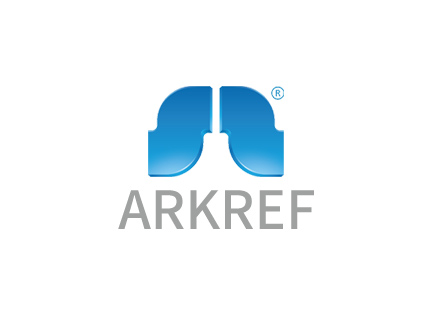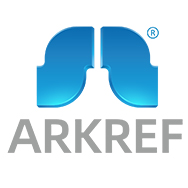Keeping Your Chiller Unit Running Smoothly and Efficiently
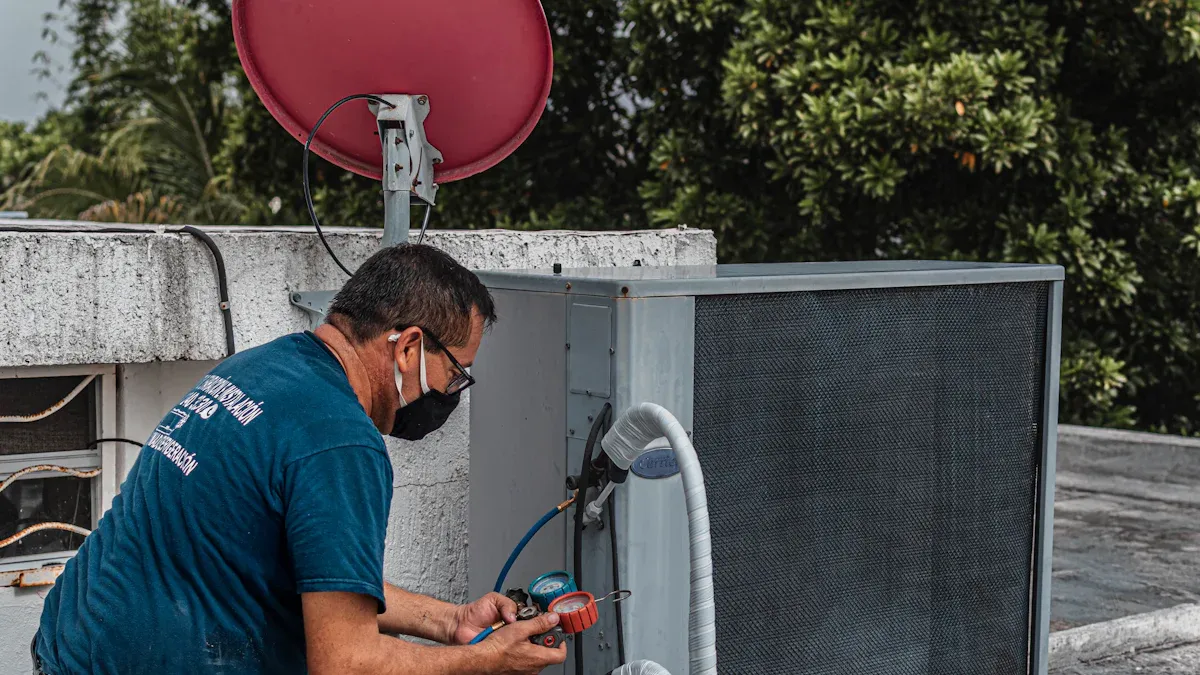
Keeping your chiller unit working well helps avoid sudden breakdowns. It also saves money and boosts performance. Regular check-ups on your chiller unit make it run better. This can cut energy bills by 15% to 20%. That’s a big amount of savings! Taking care of your chiller unit means fewer fixes. It also makes the equipment last longer. Don’t wait for problems to grow. A little care now keeps your chiller unit running smoothly.
Key Takeaways
Taking care of your chiller can cut energy costs by 15% to 20%. Small steps save big money.
Cleaning the coils and replacing filters helps it work better and last longer. Easy fixes matter a lot.
Checking refrigerant and fixing leaks stops expensive repairs. Quick fixes prevent bigger troubles.
Regular check-ups find small problems before they grow. Plan inspections to keep your chiller dependable.
Caring for your chiller saves money and helps the planet by using less energy and cutting pollution.
Why Chiller Unit Efficiency Matters
Lowering Energy Costs
Did you know a good chiller saves energy? A smooth-running system uses less power for cooling. This saves money and reduces waste. Cleaning coils and checking refrigerant levels help efficiency. These small tasks lead to big savings over time. With rising energy costs, every bit of savings counts.
Prolonging Chiller Lifespan
Caring for your chiller makes it last longer. Skipping maintenance causes wear and tear. This can shorten its life. Replace air filters and fix leaks to avoid strain. A cared-for chiller works better and lasts years. It’s like maintaining a car. Regular care prevents breakdowns and keeps it running well.
Reducing Downtime and Repairs
No one wants their chiller to fail on a hot day. Regular checks stop surprise repairs and downtime. Catching small problems early avoids big issues later. For example, fixing leaks or odd noises prevents failures. A reliable chiller means steady cooling and less stress. You’ll worry less and enjoy comfort more.
Supporting Sustainability Goals
Did you know your chiller can help the planet? It’s true! A well-maintained chiller uses less energy. This lowers greenhouse gases in the air. By caring for your chiller, you save money and help Earth.
Let’s check some real examples. Studies show efficient chillers help the environment. For instance:
Metric | Value |
|---|---|
Yearly energy saved | |
Yearly money saved | £18,097 |
Yearly CO2 cut | 18.88 tons |
10-year energy saved | 722,975 kWh |
10-year money saved | £168,487 |
CO2 saved equals | 7,552 trees planted |
Same as removing | 45 cars for one year |
Amazing, right? Small fixes can make a big difference. Imagine if all buildings improved their chillers. It would be like planting forests or removing many cars.
Here’s another way to see the impact:
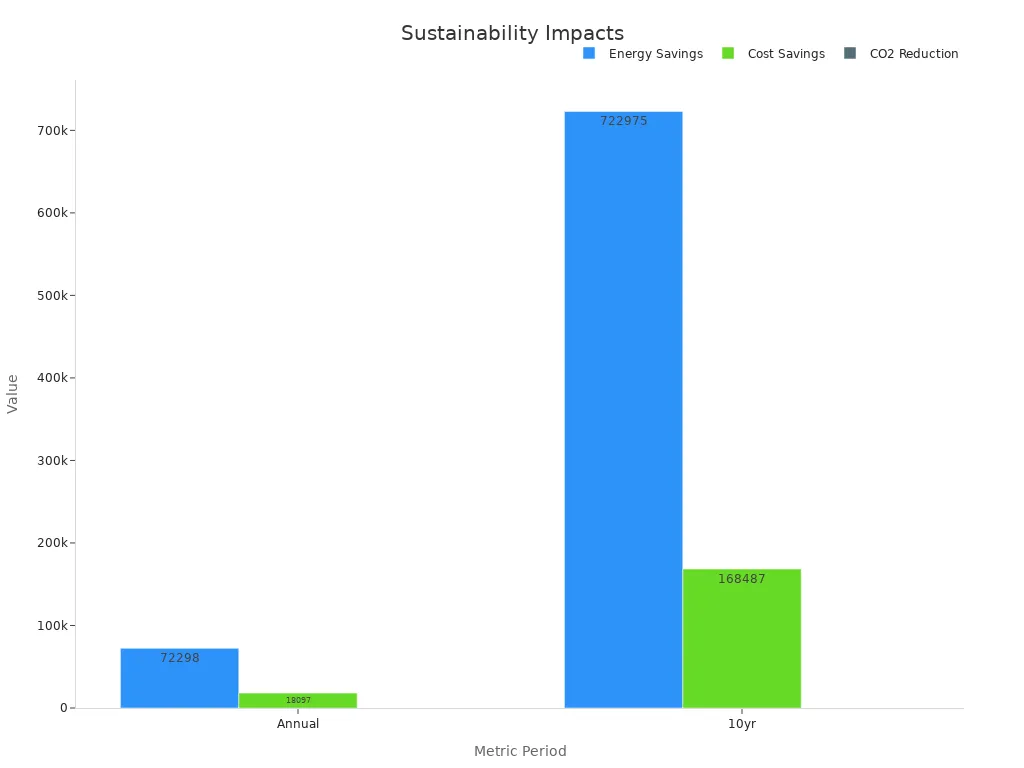
By improving your chiller, you help the planet. You save money and make Earth cleaner. Next time you do maintenance, remember—you’re making a big change.
Essential Maintenance Tips for Chiller Units
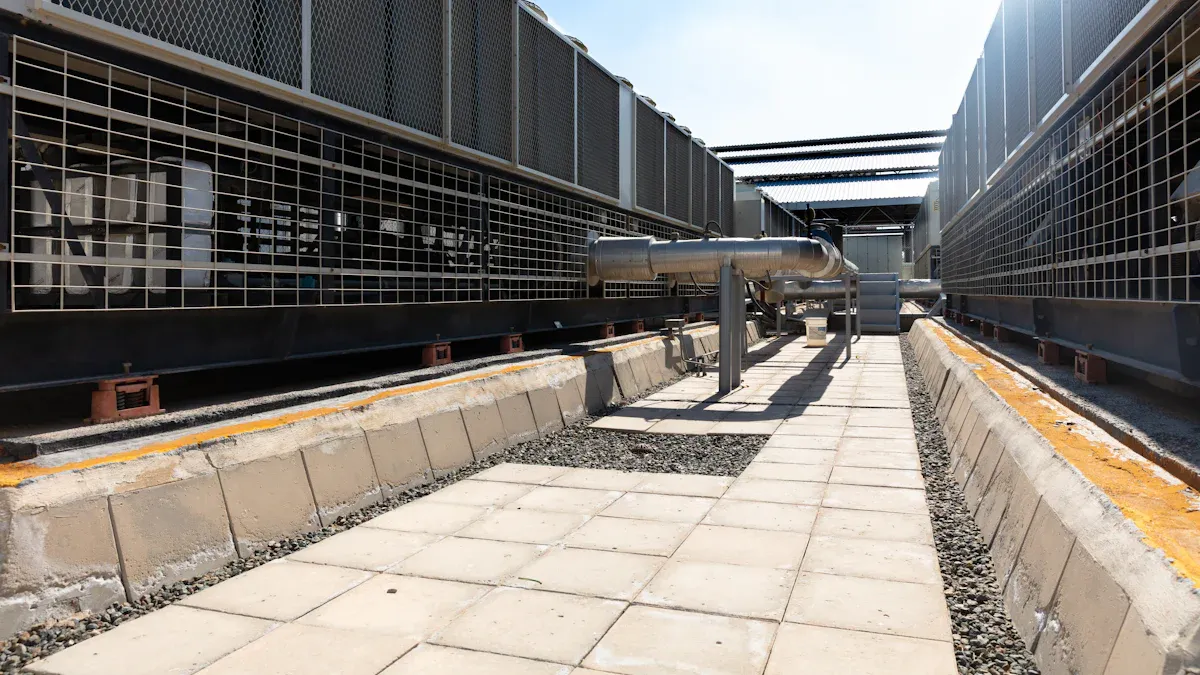
Clean Condenser Coils
Cleaning condenser coils is an easy way to improve performance. Over time, dirt and dust stick to the coils. This blocks heat transfer and makes the system work harder. When this happens, energy use goes up, and cooling gets worse.
Why should you clean the coils often?
Dirty coils can lower efficiency by up to 30%.
Clean coils allow better airflow and heat transfer.
Regular cleaning saves energy and helps your chiller last longer.
You can clean the coils yourself or hire a professional. If you do it yourself, turn off the system first. Use a soft brush or coil cleaner to gently remove dirt. This small task can greatly improve how your chiller works.
Tip: Clean the coils at least twice a year, especially before summer.
Check Refrigerant Levels
Refrigerant is what makes your chiller cool properly. If levels are too low, cooling gets worse, and energy bills rise. Very low levels can even cause the system to stop working.
To check refrigerant, look at the system’s pressure gauges. A drop in pressure means the refrigerant might be low. If this happens, call a professional to refill it. Handling refrigerants needs special tools and skills, so don’t do it yourself.
Note: Low refrigerant often means there’s a leak. Check for leaks before refilling.
Inspect and Seal Leaks
Leaks in your chiller can cause big problems. They reduce efficiency and lead to expensive repairs. Leaks often happen in refrigerant lines, seals, or connections. Even small leaks waste a lot of energy over time.
How to check for leaks:
Look for oil stains or wet spots on the system.
Listen for hissing sounds, which may mean refrigerant is escaping.
Use a leak detector for a more accurate check.
If you find a leak, seal it quickly to avoid damage. Small leaks can be fixed with HVAC sealants. For bigger leaks, call a professional. Fixing leaks early saves energy and prevents costly repairs later.
Reminder: Check for leaks regularly as part of your maintenance routine.
Replace Air Filters Regularly
Air filters are important for keeping your chiller working well. Over time, they collect dust and dirt, which blocks airflow. When airflow is blocked, the system works harder. This uses more energy and wears out parts faster.
Changing air filters often is an easy way to help your chiller. Experts suggest checking and replacing filters every 1 to 3 months. If your chiller is in a dusty area, change them more often.
Clean filters save energy and improve air quality. This is great for businesses needing cool, clean air. Keeping filters clean also prevents repairs and helps your system last longer.
Tip: Set a reminder to check filters monthly. It’s a small task that keeps your chiller running better.
Maintain Proper Water Flow
Good water flow helps your chiller work its best. If water flow is blocked, cooling gets worse, and energy use goes up.
To keep water flowing smoothly:
Check valves to ensure they handle the right amount of water.
Make sure valves can handle the system’s pressure.
Clean out debris during regular checks to avoid clogs.
These steps improve cooling and stop leaks or damage. Keeping water flow steady is like giving your chiller a tune-up. It helps everything run better and last longer.
Reminder: Check your water flow system regularly. Fixing small issues early saves energy and avoids big problems.
Schedule Routine Inspections
Regular inspections are key to keeping your chiller in good shape. They catch small problems before they become big ones. This saves time and money later. Think of it like going to the dentist—small check-ups prevent big fixes.
Here’s a simple inspection plan:
Monthly: Check refrigerant levels and electrical parts.
Quarterly: Clean coils and replace filters, especially in dusty areas.
Semi-Annually: Test compressors to ensure they work well.
Annually: Do a full check to meet manufacturer standards.
Inspections make your system work better and last longer. Staying on top of maintenance avoids breakdowns and keeps cooling steady.
Pro Tip: Hire a professional for yearly checks. They can find problems you might miss and ensure your system follows rules.
Optimize Thermostat Settings
Changing your thermostat settings can help your chiller work better. Many people forget this easy step, but it saves energy and money. Adjusting the thermostat reduces waste and keeps the system efficient.
Here’s what you can do:
Set the right temperature: Don’t set it too low. Raising it a few degrees saves energy.
Use smart thermostats: These adjust cooling based on schedules and room use. They’re perfect for offices or busy spaces.
Check out these savings:
Analysis Type | Energy Savings | Conditions | Notes |
|---|---|---|---|
Optimal Start Control | Small commercial buildings | Savings depend on layout and season | |
Smart Thermostats | Big reduction | Various commercial spaces | Adjusts cooling based on occupancy |
Smart thermostats and controls can save up to 20% or more. Imagine lowering your energy bills just by changing thermostat settings!
Tip: Program your thermostat to match your schedule. Raise the temperature during off-hours to save energy without losing comfort.
These small changes save money and reduce strain on your chiller. It’s good for your wallet and your system.
Clean Outdoor Units
Outdoor units are often forgotten, but they’re key to your chiller’s performance. Dirt, leaves, and debris can block airflow and make the system work harder. This uses more energy and wears out parts faster.
Why clean outdoor units?
Better airflow: Clean units let air move freely, improving cooling.
Stops overheating: Dirt traps heat, causing shutdowns or damage.
Lasts longer: Cleaning reduces strain, helping the system last years.
Cleaning is easy. Turn off the power first. Use a garden hose to wash away dirt gently. Don’t use high-pressure water—it can harm the fins. For tough dirt, use a soft brush or coil cleaner.
Reminder: Trim plants or bushes near the unit. Keep them at least two feet away for proper airflow.
A clean outdoor unit boosts efficiency and prevents costly repairs. It’s a simple task that keeps your chiller running well.
Signs of Chiller Inefficiency
Even well-maintained chillers can show problems over time. Spotting these early signs helps fix issues before they worsen. Let’s look at common signs of inefficiency.
Strange Noises or Vibrations
Does your chiller make odd sounds? Strange noises like banging, hissing, or grinding often mean mechanical trouble. Vibrations might show loose or unbalanced parts. Ignoring these signs can cause bigger problems, like system breakdowns.
Watch for these sounds:
Banging or clanking: This may mean parts inside are loose or broken.
Hissing sounds: These could mean refrigerant is leaking.
Grinding noises: Worn bearings or motor problems might be the cause.
Loud noises don’t just annoy—they lower efficiency. If you hear anything unusual, call a professional to check your system.
Tip: Regular maintenance stops these problems. Tighten loose parts and lubricate moving pieces to keep your chiller working well.
Rising Energy Bills
Higher energy bills can mean something’s wrong. When your chiller works harder than needed, it uses more power. This wastes energy, costs money, and strains the system.
Here’s how inefficiency affects energy use:
Metric | Description |
|---|---|
Energy Bills | Sudden increases show higher power use from inefficiency. |
Noise Levels | Loud sounds may mean mechanical trouble inside the chiller. |
Cooling Consistency | Uneven cooling shows airflow or load problems. |
Humidity Levels | High humidity means poor moisture removal by the chiller. |
Air Quality | Bad smells may mean mold or refrigerant leaks, harming air quality. |
Frequency of Breakdowns | More repairs suggest deeper issues or skipped maintenance. |
Response Times to Settings | Slow cooling may mean refrigerant issues or clogged filters. |
If bills keep rising, check for clogged filters, leaks, or dirty coils. Small problems can greatly lower efficiency.
Reminder: Compare current bills to past ones. A big increase often signals a chiller problem.
Uneven Cooling
Uneven cooling is another warning sign. If some rooms feel too cold and others too warm, your chiller might be struggling. This often happens due to airflow issues, broken thermostats, or clogged filters.
What causes uneven cooling?
Airflow problems in different building areas.
Thermostats not controlling temperatures correctly.
A chiller that can’t meet the building’s cooling needs.
Uneven cooling affects comfort and energy use. For example, warm rooms make people uncomfortable, while cold spots waste energy.
Pro Tip: Check thermostats and airflow systems often. Fixing these early improves performance and keeps everyone comfortable.
Spotting these inefficiency signs helps your chiller work better. Fixing problems early saves energy, lowers costs, and extends your system’s life.
Frequent Shutdowns or Alarms
Does your chiller keep stopping or setting off alarms? This shows something is wrong. Shutdowns can mess up cooling and raise energy costs. Ignoring these warnings might damage the system for good.
Why does this happen?
Overheating: Hot parts like the motor or compressor shut down to avoid harm.
Electrical Problems: Bad wiring or loose parts can turn off the system.
Refrigerant Issues: Leaks or low refrigerant levels stop the chiller from working.
Blocked Airflow: Dirty filters or clogged coils make the system overwork, causing shutdowns.
What should you do? Check for simple problems like dirty filters or blocked airflow first. If the issue doesn’t go away, call an expert. They can find the problem and fix it before it gets worse.
Tip: Write down when and why your chiller shuts off. This helps experts figure out the problem faster.
Shutdowns and alarms don’t just waste energy. They also make repairs cost more and disrupt comfort. Fix these problems quickly to keep your chiller working well.
Visible Corrosion or Leaks
Do you see rust or wet spots near your chiller? These are signs of trouble that need fixing fast. Rust weakens metal parts, and leaks waste refrigerant or water. Both problems lower efficiency and cost a lot to repair.
What should you look for?
Rusty Pipes or Parts: Rust often starts on pipes, coils, or fittings.
Wet Spots or Puddles: These may mean water or refrigerant is leaking.
Discolored Metal: Green or white marks could show chemical reactions from leaks.
Why does this happen? Rust forms when moisture or chemicals touch metal parts. Leaks happen because of worn seals, loose connections, or damage.
How can you stop this?
Check your chiller often for rust or leaks.
Use coatings to protect metal parts from rust.
Tighten loose parts and replace old seals.
Reminder: Don’t try to fix refrigerant leaks yourself. Special tools and training are needed for this job.
Ignoring rust or leaks can cause bigger problems, like system failure or harm to the environment. Fixing these early saves energy, keeps your chiller running longer, and ensures steady cooling.
When to Seek Professional Chiller Maintenance
Even with regular care, sometimes your chiller needs expert help. Knowing when to call a professional can save time and money. Let’s look at when expert maintenance is necessary.
Ongoing Performance Issues
If your chiller isn’t cooling well, don’t ignore it. Uneven cooling, higher energy bills, or frequent shutdowns mean something’s wrong. These problems often need more than basic fixes. For example, a broken compressor or blocked refrigerant lines can make the system work harder.
You can try cleaning filters or adjusting the thermostat. But if the issue doesn’t go away, call a professional. Experts can find hidden problems and fix them fast. This gets your chiller working properly again.
Tip: Write down repeated issues. It helps technicians find the problem faster.
Difficult Repairs or Replacements
Some repairs are too hard to do yourself. Complex systems need special tools and skills. For example:
DIY fixes often fail on tricky chiller parts.
Installing parts wrong can make the system less efficient.
Only licensed EPA technicians can legally handle refrigerants.
If your chiller needs big repairs or new parts, call an expert. They’ll do the job safely and correctly. Trying to fix it yourself can cause more damage or cost more later.
Reminder: Always hire certified technicians for refrigerant work or upgrades.
Yearly System Check-Ups
Even well-maintained chillers need yearly inspections. Annual check-ups keep everything running safely and efficiently. During these, professionals clean parts, check components, and find potential problems.
Why is this important? Over time, wear and tear lowers efficiency. A yearly inspection catches issues early and avoids expensive repairs. It also helps save energy and money.
Pro Tip: Plan your yearly check-up before summer. This ensures your chiller is ready for hot weather.
Knowing when to call a professional keeps your chiller efficient and reliable. Trust experts for tough jobs and yearly maintenance to avoid breakdowns.
Ensuring Compliance with Regulations
Following rules for your chiller keeps it safe and efficient. It also avoids fines or shutdowns. But how can you ensure your system meets the rules? Let’s simplify it.
First, learn the local and national rules for chillers. Some areas have strict guidelines for refrigerants, energy use, and inspections. For example, only certified technicians can handle refrigerants in many places. If you’re unsure, check your manual or ask a professional.
Next, keep records of all maintenance work. Write down inspections, repairs, and refrigerant use. These records show you’re following the rules and help track your system’s health over time.
Also, schedule regular checks with licensed experts. They can spot problems early, like leaks or old parts. Professionals also ensure your system meets energy standards and handles refrigerants properly.
Lastly, stay updated on rule changes. Laws about refrigerants and energy efficiency may change. Knowing the latest rules helps you adjust your system and avoid trouble.
Tip: Work with a trusted HVAC company. They’ll handle compliance and keep your chiller up to date, so you can focus on your business.
By following these steps, your chiller will stay safe, efficient, and within the rules. It’s good for your system and your peace of mind.
Taking care of your chiller isn’t just about stopping breakdowns. It also saves money and keeps everything working well. Regular upkeep helps your chiller last longer, work better, and use less energy.
Here’s a simple list of what to do:
Keep condenser coils and outdoor units clean.
Check refrigerant levels and fix any leaks.
Change air filters and ensure water flows properly.
Plan regular check-ups and adjust thermostat settings.
Don’t let small problems turn into big, expensive ones. Fix issues early, and if unsure, call an expert. Your chiller will run better and cause fewer problems!
FAQ
How often should you clean the condenser coils?
You should clean the condenser coils at least twice a year. Focus on doing this before summer and winter. Dirt and debris build up quickly, so regular cleaning keeps your chiller efficient and prevents overheating.
Tip: If your area is dusty, clean the coils more often for better performance.
What’s the best way to check refrigerant levels?
Look at the pressure gauges on your chiller. A drop in pressure usually means refrigerant levels are low. Don’t try to refill it yourself. Call a certified technician to handle refrigerants safely and legally.
Reminder: Low refrigerant often signals a leak. Fix leaks before refilling.
Can you replace air filters yourself?
Yes, replacing air filters is simple. Check them monthly and replace them every 1 to 3 months. If your chiller operates in a dusty environment, change them more often. Clean filters improve airflow and save energy.
Tip: Keep spare filters handy for quick replacements.
What should you do if your chiller keeps shutting down?
Start by checking for dirty filters, blocked airflow, or overheating. If the problem persists, write down the shutdown details and call a professional. They’ll diagnose and fix the issue before it causes further damage.
Pro Tip: Regular maintenance prevents shutdowns and keeps your chiller reliable.
How can you tell if your chiller has a leak?
Look for oil stains, wet spots, or hissing sounds near the system. Use a leak detector for accuracy. Seal small leaks with HVAC sealants, but call a professional for larger ones.
Note: Fix leaks quickly to avoid energy waste and costly repairs.
See Also
Proven Strategies to Enhance Walk-In Chiller Efficiency
Maximizing Performance of ARKREF CO₂ Chillers and Compressors
A Comprehensive Guide to Water Chiller Unit Functionality
Essential Maintenance Tips for Optimal Plate Freezer Function
